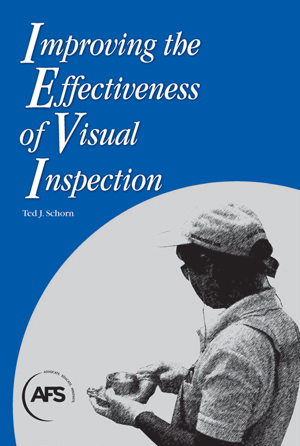A new book from the American Foundry Society by quality inspection expert Ted J. Schorn is gaining a reputation as a must-have for industrial libraries.
Based on Schorn’s firsthand experience in examining different visual inspection procedures, Improving the Effectiveness of Visual Inspection teaches readers to minimize or eliminate quality issues in manufactured products. The book has garnered praise, including from Douglas C. Wood of the Quality Management Division of the American Society of Quality. Mr. Wood’s review of Improving the Effectiveness of Visual Inspection is below:
Book Report: Improving the Effectiveness of Visual Inspection
If you desired to ensure your visual inspection system is as effective as possible, you used to need access to a wide variety of  research sources and time to integrate these diverse sources into your planning, execution, and maintenance for this human- based inspection system. Automation is sometimes the right tool but there are many situations where human visual inspection is best. Now there is a book to help with these tasks.
research sources and time to integrate these diverse sources into your planning, execution, and maintenance for this human- based inspection system. Automation is sometimes the right tool but there are many situations where human visual inspection is best. Now there is a book to help with these tasks.
In Improving the Effectiveness of Visual Inspection, Mr. Ted J. Schorn has done the sourcing, reading, digesting, ordering, assembling, indexing, and referencing these many sources to create a book that quality practitioners may use to improve any kind of human visual inspection system. His writing style is clear and straightforward, and his work is documented with over 200 references.
The chapter order is designed for practitioners and follows a logical order, except for the final unit “Warnings and Advice.” This reviewer feels it would have been better to place this unit at the start. The warnings and advice are sound, where ever they are placed.
A list of selected significant material contains: how good is the visual inspector (p.11), this book’s methodology (p.19), assumptions about measuring inspector performance (p.23), problems with multiple inspections (p.37 and all of chapter 10), performing a measurement systems analysis on inspection (Pp.38-88), a model of the inspection task (p.96), human error (Pp.122-127), the basics of visual search (Chapter 5), advantages and risks of digital images used for instruction (p.182), factors in decision making used by inspectors (p.215), application of bar coding to data recording (p.241), and in-depth material on training (Chapter 8). This is not a complete list of significant material, but merely a list to show the breadth of this book.
This reviewer believes this book belongs in every industrial library where visual inspection is planned or managed. It will find appropriate use for a long time, as Mr. Schorn’s references to the limitations of machine vision indicate. Humans will be needed for inspection for many years: we should base our management of inspection on the best available research. This book fills that need.
To purchase Improving the Effectiveness of Visual Inspection, please visit the AFS Bookstore.
Douglas C. Wood of DC Wood Consulting, LLC, is vice-chair of webinars and education for the Quality Management Division of the American Society of Quality (ASQ).
The American Foundry Society is a dynamic technical and advocacy organization that serves and represents the $33 billion metalcasting industry. AFS is the only association serving the entire industry, including all metals and processes, with a three-part focus on advocacy, education, and innovation. AFS also publishes Modern Casting and Metal Casting Design & Purchasing magazines and presents Metalcasting Congress and CastExpo, the largest metalcasting trade events in North America. Founded in 1896, the organization is based in Schaumburg, Illinois, with an advocacy office in Washington, D.C. More information is available at afsinc.org.